
At a Glance
Expert’s Rating
Pros
Desktop graphics performanceOverclockable Skylake CPUG-sync monitor helps smooth out low frame rates
Cons
Thumb buttons on trackpad difficult to pushExpensive and most don’t need 32GB of RAM
Our Verdict
The GT72S is proof you can now get desktop-class performance in a laptop.
Best Prices Today: MSI GT72S Dominator Pro G Dragon
RetailerPrice $3100View DealPrice comparison from over 24,000 stores worldwideProductPricePrice comparison from Backmarket
$3100View DealPrice comparison from over 24,000 stores worldwideProductPricePrice comparison from Backmarket
MSI’s GT72S Dominator Pro G Dragon breaks barriers unheard of just a few years ago by offering desktop-class CPU performance, desktop-class storage performance and desktop-class graphics performance in a laptop.
The attention-grabber here is the use of Nvidia’s new GeForce GTX 980 chip, which promises 1:1 performance of the desktop GeForce GTX 980. Yes, really. No joke.
If you need it explained in pictures, it’s like Nvidia took this:

and jammed it into this.
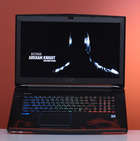 IDG
IDGBam.
Don’t yawn, you cynical gamer. Sure, we’ve been able to get GeForce GTX 980M graphics chips all year long, but that part has only 75 percent of its desktop counterpart’s power. With the confusingly named GeForce GTX 980 mobile chip, it’s true desktop performance at last.
Before we dive into performance, more on this striking Dragon. It might seem like just a reissue of the older GT72 Dominator. There’s one big difference on the outside: The dragon on the lid of the laptop casts a glowing eye when the laptop is powered on. It’s a big upgrade over the rather sedate, black lid of the older GT72 Dominator.
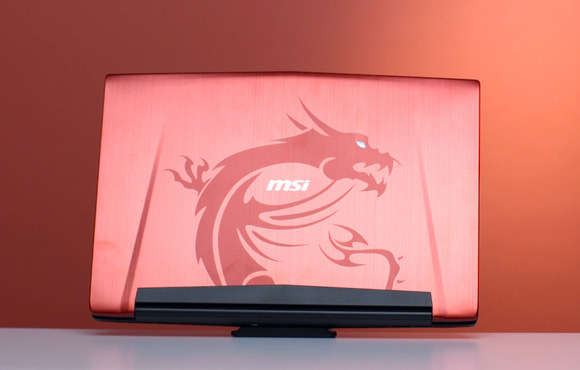 IDG
IDGEnter The Dragon. MSI’s GT72S Dominator Pro G Dragon features a, well, red dragon on its aluminum lid with an eye that glows when on.
A redesigned keyboard makes the keys brighter. Those keys, unfortunately are still just zone-lit—MSI officials cited the cost and power consumption of a per-key RGB setup. The keyboard uses standard dome keys—if you want mechanical keys, you’ll have to pony up for the GT80 Titan SLI.
 Gordon Mah Ung
Gordon Mah UngThe keyboard is changed from last year’s GT72 to even brighter than before. It’s still just zone lighting though rather than per-key lighting.
The keyboard was fine, but I’m still no fan of the buttons on the trackpad. They just take too much pressure for your thumb to activate. I found myself using my off hand’s index finger to click the trackpad’s buttons after my thumb became tired.
Inside you’ll find other key changes. The GT72 Dominator featured two miniDisplayPorts and HDMI outputs. The GT72S Dragon trades one mDP for a Thunderbolt 3.0 combo USB-C port.
For storage you get a 1TB hard drive and an LG Blu-Ray burner with M-Disc support. The primary drive is pretty exotic: a pair of Samsung SM951 M.2 PCIe drives in RAID 0. The two drives combined can cook off sequential transfers speeds, with large queue depths up to 2.8GBps reads and 1.3Gbps writes in CrytalDiskMark 5. The only minus? The drives are a measly 120GB each.
Overclocking-ready CPU with all the trimmings
Inside the shell of the GT72S Dragon you’ll find an Intel quad-core Skylake Core i7-6820HK chip. The CPU is unlocked, but the factory default is 2.7GHz to 3.6GHz on Turbo-Boost.
Rather than the fancy whiz-bang UI that desktop motherboards get, the GT72S Dragon’s BIOS looks like it was lifted from a motherboard from 2001. There’s no mouse control, no print screen option and nothing to walk you through your overclocking attempts. It’s bare-bones. I’d expect this to improve if overclocking of laptops actually turns into a thing.
For my tests I dialed up a quick overclock to 4GHz from its stock speed of 3.2GHz. Even with the 4GHz overclock, the CPU fan speeds didn’t get obtrusive. Only under a stress test do the fans get up and go. Overall, I’d say fan noise on the GT72S was kept to a minimum.
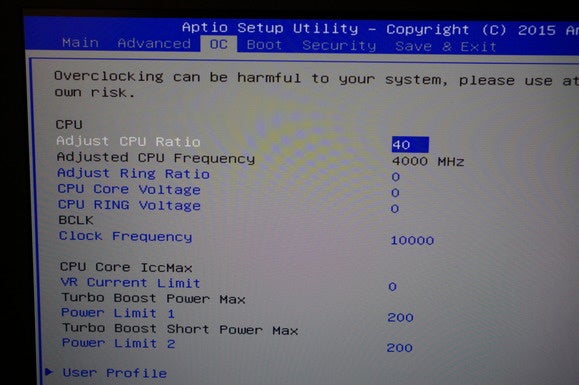 Gordon Mah Ung
Gordon Mah UngThe BIOS in the MSI GT72S Dragon pales in comparison to a good motherboard’s, but it’s at least functional and let us easily dial up a 4GHz overclock on the Skylake chip.
Because it’s Skylake, MSI pairs the CPU up with an excessive amount of DDR4/2133 RAM using four DIMM slots. By excessive I mean few people really need 32GB—but hey, why not go all in right?
G-Sync display for smoother gaming
The GT72S Dragon features a G-sync certified panel. The problem, of course, is that with the 17.3-inch 1920×1080 IPS screen and the GeForce GTX 980, it’s going to be really hard to get frame rates to drop to the 30 and 40 fps range where G-sync is the most effective.
There are benefits: For example, the G-sync panel is rated for 75Hz, so you’ll get a slightly smoother feel in gaming and even scrolling or moving windows around. It’s not quite to the level of a 120Hz or 144Hz panel, but it’s better than 60Hz.
G-sync also brings anti-ghosting and even works in a window, but the truth is it’s hard to drag down a GeForce GTX 980 even at 1080p gaming.
GPU Performance
None of the fancy Dragon stuff matters if the laptop doesn’t deliver, and it does. I ran 3DMark Firestrike Extreme on the GT72S Dragon and compared it to some beefy laptops plus our PCWorld Zero point desktop system with a GeForce GTX 980. The result? The Dragon is actually slightly faster than our desktop system.
 Gordon Mah Ung
Gordon Mah UngDoes the laptop GeForce GTX 980 stackup to a desktop GeForce GTX 980? Yup.
To see how the part stacks up in a real game, I also ran Tomb Raider set to Ultimate quality and at 1920×1080 resolution. I unfortunately don’t have our Zero Point at the lower resolution handy, but the only laptop that we’ve seen with more performance from is one with two GeForce GTX 980M cards in SLI.
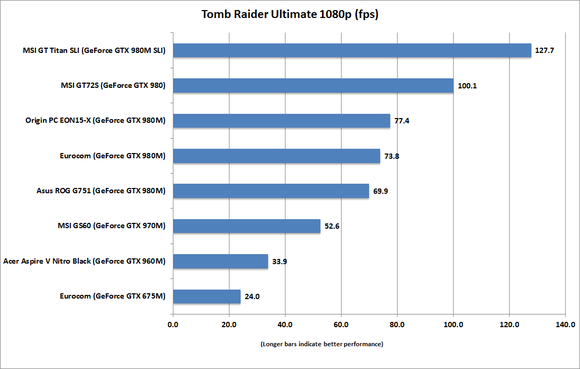 Gordon Mah Ung
Gordon Mah UngHere’s how the MSI GT72S Dragon stacks up in a real game.
I also threw Middle-earth: Shadows of Mordor with the 4K texture pack and Ultra-quality setting enabled. I have a somewhat smaller set of comparison numbers here, but the GeForce GTX 980 easily schools the GeForce GTX 980M chips.
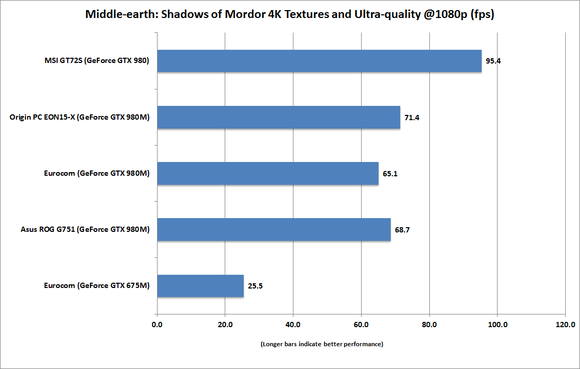
The MSI GT72S Dragon performance in Middle-earth: Shadows of Mordor is also top notch.
CPU Performance
We all know gaming laptops do more than play. People who buy these honking big laptops also tend to edit video, photos, or do other content creation-oriented tasks.
The first test is PCMark 8 Home Conventional. It’s a synthetic benchmark designed to measure typical usage in a “home” environment and includes browsing, video editing, photo editing, word processing and light-duty gaming. It’s a fairly easy test that any machine can do, but it favors the higher clock speeds like the desktop chips in our zero-point testbed and the Origin PC EON15-X.
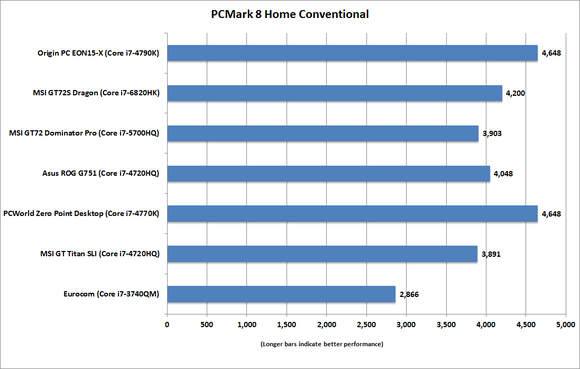
PCMark 8 Home measures low ambition gaming and general CPU performance in typical home (yawn) tasks.
A more strenuous workload is our Handbrake encode test. We take a 30GB, high bit-rate 1080P MKV file and encode it using the Android Tablet preset. Handbrake is heavily multi-threaded: The more cores, the higher the performance. On the GT72S Dragon, I ran the test two ways. The first was at the stock speeds for the chip, and the second was with the laptop’s CPU overclocked to 4GHz. The results are impressive.
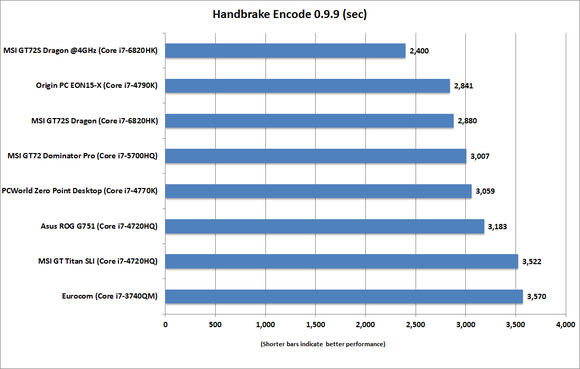
The default clocks of the GT72S Dragon’s Skylake chip is a tad slow but overclocked to 4GHz, it’ll school even a desktop chip.
If you look at the chart above, you can see the Skylake chip turns in a better performance than the Core i7-4770K in our Zero Point desktop box. However, it loses to the Origin PC EON15-X with its higher-clocked Devil’s Canyon chip. With the 4GHz overclock on the Skylake chip, we see a large performance increase over the other quad-core CPUs. Note that I didn’t vet the 4GHz overclock for long term stability, to just to see how fast it would run. My guess is it’s an attainable overclock, as it was fully stable during multiple 40 minute encode runs.
Let’s look inside
I don’t typically take apart review laptops, but the GT72S Dragon was too intriguing to pass up. To open up the GT72S Dragon, just remove the perimeter screws along with the one under the warranty sticker (a hint?), then carefully pry off the lid.
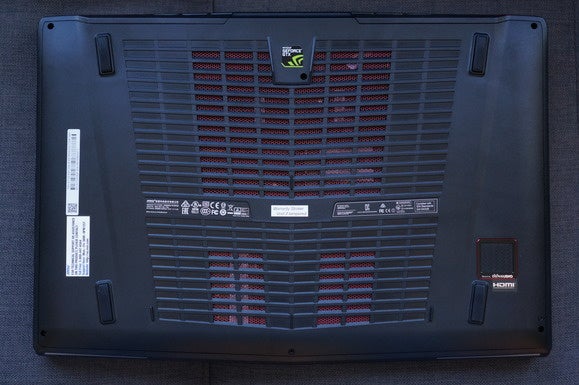 Gordon Mah Ung
Gordon Mah UngThe MSI GT72S Dragon is well vented and generally fairly quiet except under the most extreme GPU loads.
Here’s the actual inside of the GT72S Dragon. It’s fairly straightforward, with easy access to most of the components. The laptop actually uses four 8GB DDR4 SO-DIMMs, so I’m guessing the other pair is embedded on the other side of the motherboard. The GeForce GTX 980 is under the cooler on the right in an MXM module while the Core i7-6820HK is soldiered to the motherboard on the left. And no, you can’t swap the CPU out, as Intel stopped making CPUs for laptops using sockets beginning with the mobile Broadwell CPUs.
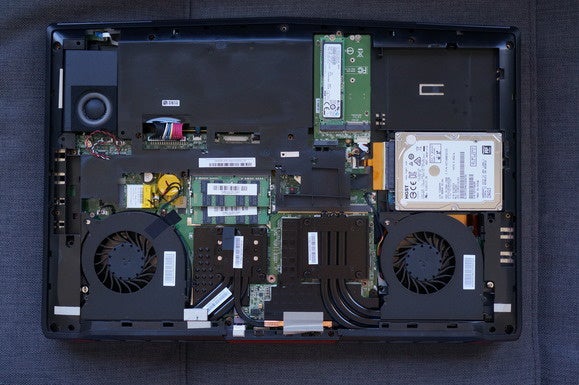 Gordon Mah Ung
Gordon Mah UngAccess to the guts of the MSI GT72S Dragon is just seven screws away—provided you’re not afraid of voiding your warranty.
There’s one other gut shot that’s really worthy of getting detail on and that’s the storage sub-system. MSI actually uses a small daughtercard to mount the M.2 drives to. I didn’t disassemble it any further, but I believe up to four M.2 drives can be mounted to it. That means up to four M.2 drives in RAID 0 performance for even more over-the-top read and write speed.
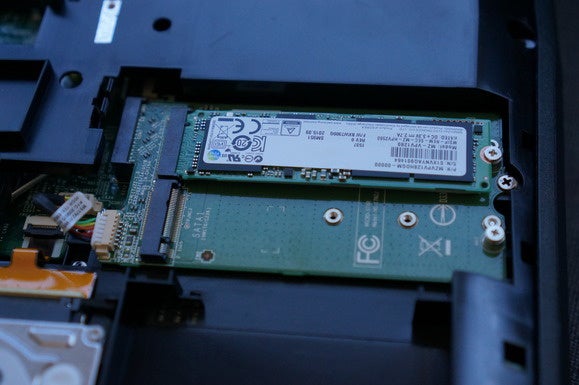 Gordon Mah Ung
Gordon Mah UngMSI uses an interesting daughter card that I believe mounts up to four M.2 drives on it.
Is it worth it?
There’s no question the GT72S Dragon is kick-ass in performance. You’re getting pretty much desktop-level performance without any compromises in gaming, compute and storage. It’s also not very cheap: The configuration I received notches $3,100 into your credit card. That price will have every single desktop user chiming in and saying: ”It ain’t worth it, just buy a desktop.”
Even if we bought into the narrative that there’s simply no value to a powerful gaming laptop that can be zipped up into the included backpack (thanks MSI!) in 60 seconds,we’d need benchmarks to know the truth.
I went to PCpartpicker.com and spec’ed out a similar gaming PC. I didn’t pick low-end components such as a $50 case or $4 power supply, but I didn’t pick over-the-top components either. That desktops cost? Roughly $1,729 including the OS. That includes an OCZ Revo PCIe card, which is actually slower than the pair of M.2 drives in the MSI but about the only comparable thing I could find in the same capacity range. Also note the GeForce GTX 980 I picked—an MSI one—packs only 4GB instead of the 8GB that the laptop’s GPU has. There are actually no 8GB GTX 980 cards I could find. You can see my build here.
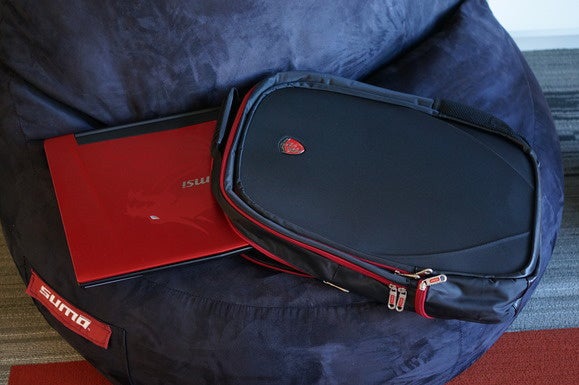
This a very nice touch: The 8 lbs. 9 oz. GT72S Dragon comes with a backpack capable of swallowing the laptop and all your gaming gear needs too.
But wait: That’s just for the PC itself. With a gaming laptop, you’re also getting a monitor, a keyboard, a mouse, and speakers. In the GT72S Dragon’s case, it’s not just a cheap monitor either, it’s an IPS G-sync panel. That might add another $500 on a new PC. Once you toss in a good gaming keyboard for $100, and a pair of speakers or headset for $50 plus a mouse and webcam you’re up to roughly $2,500 for a complete system with somewhat equivalent specs.
That means the price premium for the GT72S Dragon is around $600. Is it worth it? No, not if you never place any value portable gaming performance. If you just never bring your rig to a friend’s house on a whim (which you can do with a gaming laptop) or with you on a weekend trip, then no, why buy a gaming laptop? Get a desktop.
But if you are the kind of person who does need gaming you can take with you on a month-long trip or an overseas deployment, then the price premium is well worth it.
Are there improvements to be made? Sure. As neat as it is to see 32GB in a laptop, I’d shave that in half for the savings because the vast majority of people just don’t need 32GB of RAM. While under a normal GPU load or even overclocked to 4GHz, the GT72S Dragon fan noise was reasonable—but on occasion, especially when coming out of standby, the fans would run at a loud full speed for a few seconds. And yeah, those trackpad buttons. I imagine the factory technician who calibrated them could lift a Buick with her thumbs if these felt normal to her.
If you can overlook those faults, what you’re getting with the GT72S Dragon is truly desktop performance in a laptop.
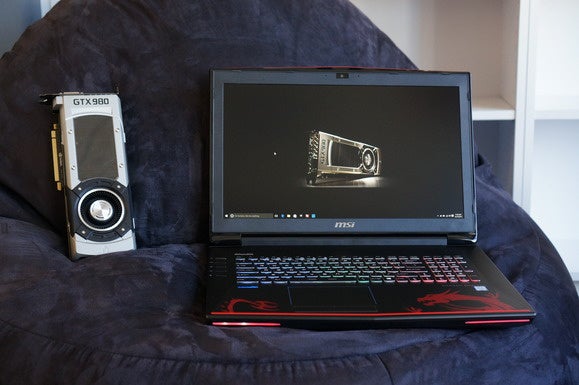 Gordon Mah Ung
Gordon Mah UngImpressive: You get every bit of performance of the GeForce GTX 980 card on the left inside a semi-portable laptop.
Best Prices Today: MSI GT72S Dominator Pro G Dragon
RetailerPrice $3100View DealPrice comparison from over 24,000 stores worldwideProductPricePrice comparison from Backmarket
$3100View DealPrice comparison from over 24,000 stores worldwideProductPricePrice comparison from Backmarket



